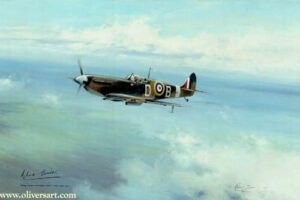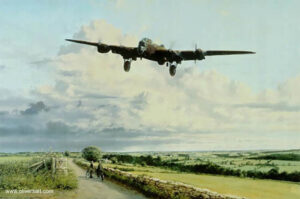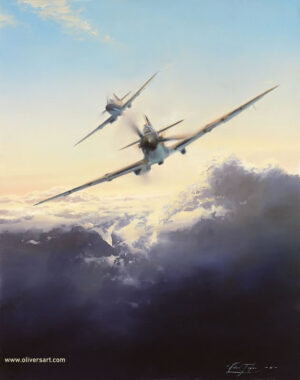Description
Rare Print
One name stands out above all others in the annals of air fighting – Erich Hartmann. His prowess in combat became legend even before the course of WWII was run. His 352 aerial victories is a record that is never likely to be surpassed. As the deeds of the great aces of WWII become misted in time, his name above all, will be remembered for his astonishing record.
Supreme flying skills with the courage and ability to push his aircraft to the very limit, were his trade mark. His method of attack was to approach at high speed and get in so close to his adversary ‘ that his aircraft filled my windshield’ before firing his guns. This required great flying skill, considerable nerve, and was not without its problems: On eight occasions Hartmann’s own aircraft was brought down by the debris of his opposite number.
Robert Taylor’s dramatic limited edition Knights Cross recreates one of the ‘blond knight’s’ famous combats high over the Eastern Front. Depicting a typical high speed pass, Hartmann’s Me109 has closed to within 100 metres of the Russian Ilyushin II, ignoring the stream of rear facing machine gun fire, to nail his quarry with pin point accuracy. Hartmann makes his cross decisive and effective and another victory is recorded for the world’s greatest fighter ace.
Each print is individually signed by the highest scoring aerial combat fighter Ace in history Colonel Erich Hartmann, who flew over 1400 combat missions and was awarded Germany’s highest military honour, the Knight’s Cross with oak leaves swords and diamonds.
Overall print size: 33 inches wide x 24 inches high.
ERICH HARTMANN 1922 – 1993
During an astonishing 1400 combat mission career, operating on the Eastern Front between 1942 – 1945, Erich Hartmann was credited with 352 Aerial Victories, to become the highest scoring fighter Ace in history. It is a record likely to stand for all time.
Learning to fly gliders in his teens the young Erich showed an unusual talent in the air and, by the age of 16, was a qualified glider instructor. Joining the Luftwaffe when old enough he started training in October, 1940, and celebrated his 20th birthday by checking out on the Me109.
In August, 1942, he was posted to Russia, joining JG-52 under its highly respected Kommodore, Dieter Hrabak. In common with other novice pilots joining his Wing, Hrabak assigned Hartmann to fly as wingman to one of his senior pilots, Paule Rossman.
Operating west of Mostock on the northern side of the Caucasus Mountains, Erich Hartmann scored his first victory on November 5, 1942, but it was not until spring of 1943 that Kommodore Hrabak realised that in Erich Hartmann he had more than just an ordinary fighter pilot. By April his new protege had claimed 11 victories, no mean score for a pilot with less than 6 months combat experience. By summer of that year he was flying upwards of 4 missions a day, rarely coming home without a victory. On July 7, he scored 7 kills in one day, and it was not long before the young Hartmann was catching up with the scores of some of the Wing’s more illustrious Aces, Walter Krupinski, Gerhard Barkhorn and Gunther Rall.
Hartmann spurned the more traditional techniques of deflection shooting favoured by most fighter pilots, always claiming he was no marksman. His approach was to bide his time until the moment of attack was right, then bore in at high speed, getting as close as possible to his quarry before firing. He claimed that this technique, which took great courage and inordinate piloting skills to avoid mid-air collision, made each attack more effective, and conserved ammunition. It was not however without its hazards – of the 16 times Hartmann was forced down, 8 were as a result of flying into the debris of Russian aircraft he had exploded at point-blank range.
As his aerial victories multiplied, so did his status within JG-52, and by the war end, with the rank of Major, Erich Hartmann was Group Commander of I./JG-52.
During an astonishing 1400 combat missions his personal score had mounted to an incredible 352 air-to-air victories, and he had been decorated with the Knight’s Cross with Oak Leaves, Swords and Diamonds – Germany’s highest military award.
Of all this great fighter pilot’s accomplishments, the one of which he was most proud was that in all his long combat career he never lost a wingmen. That meant as much to him as any one of his 352 victories, and speaks volumes for the character of the man described as the greatest Ace of them all – ‘The Blond Knight’ – Colonel Erich Hartmann.




